TUESDAY TRIAGE #46
by Vadim Drobinin ¶
Your weekly crème de la crème of the Internet is here!
01.06.2021 (read in browser)
On grasshoppers garum ¶
In my search for perfection I had a chance to make ramen again.
Last time we've learnt a lot, so this week prepared ajitsuke tamago some time ahead, decided not to do noodles from scratch, and had two different broths.
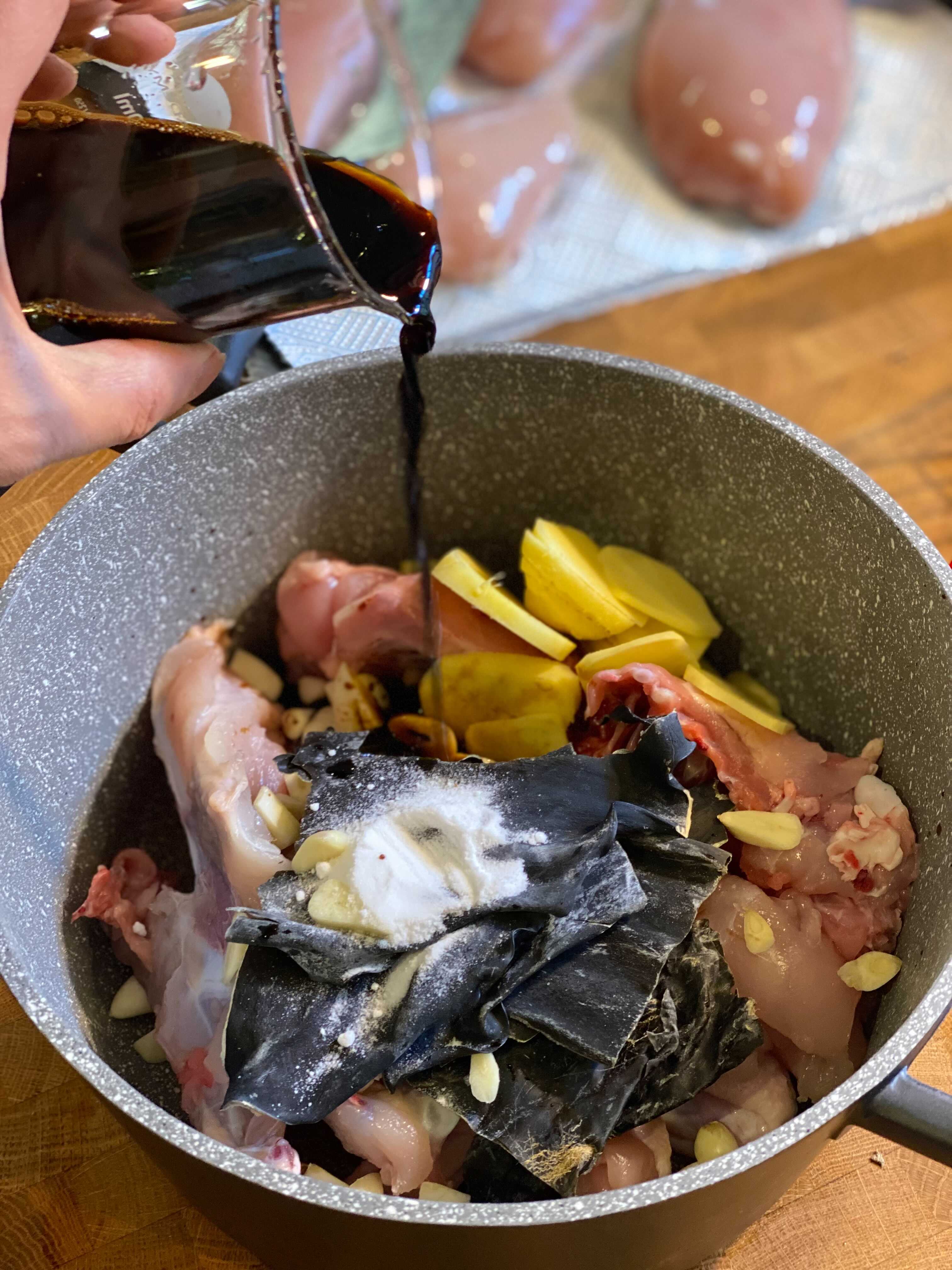
My main takeaway is that akin techniques in other cuisines, this is totally fine to re-use bones and kombu for multiple stocks. The second one has a cleaner and lighter taste, but if blended it emulsifies and becomes "milky". This is called paitan.
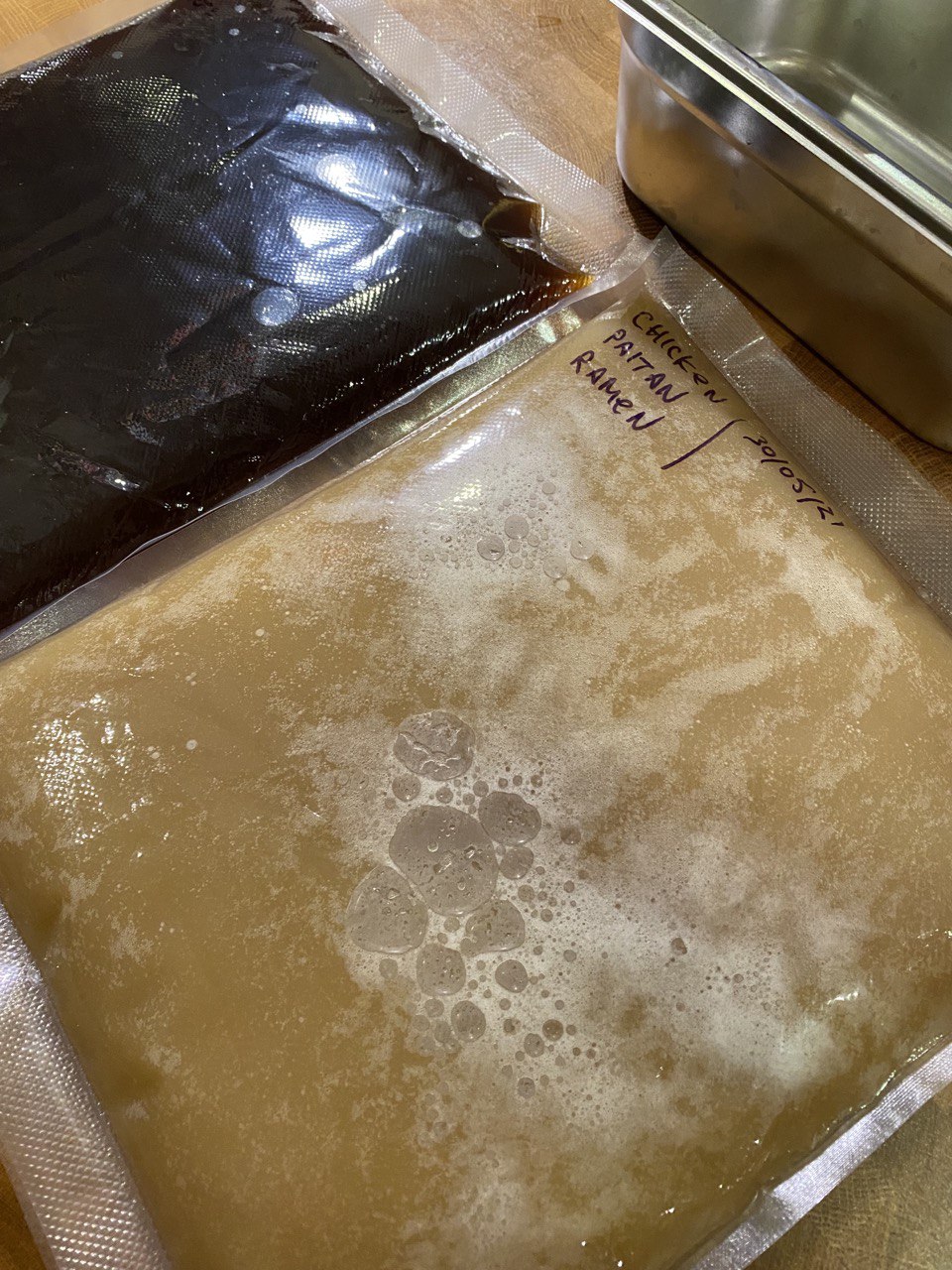
The first ramen was a shoyu ramen with black pepper chicken, which is rather classic:

But for the other one I thought I should take it a bit further and made some garums, ancient fermented sauces.
Garums are usually quite time consuming: they rely on autolysis, or self-digestion, which destructs cells through the action of their own enzymes.
The most common example is the fish sauce. One needs some raw fish, which is stored in a cool dry place for a few months and as it begins to rot it gets self-digested, and its proteins turn into, well, essentially MSG. How cool is that?!
I didn't really fancy waiting for months, so had to speed up the process significantly by using same enzymes but packed into some food supplements.
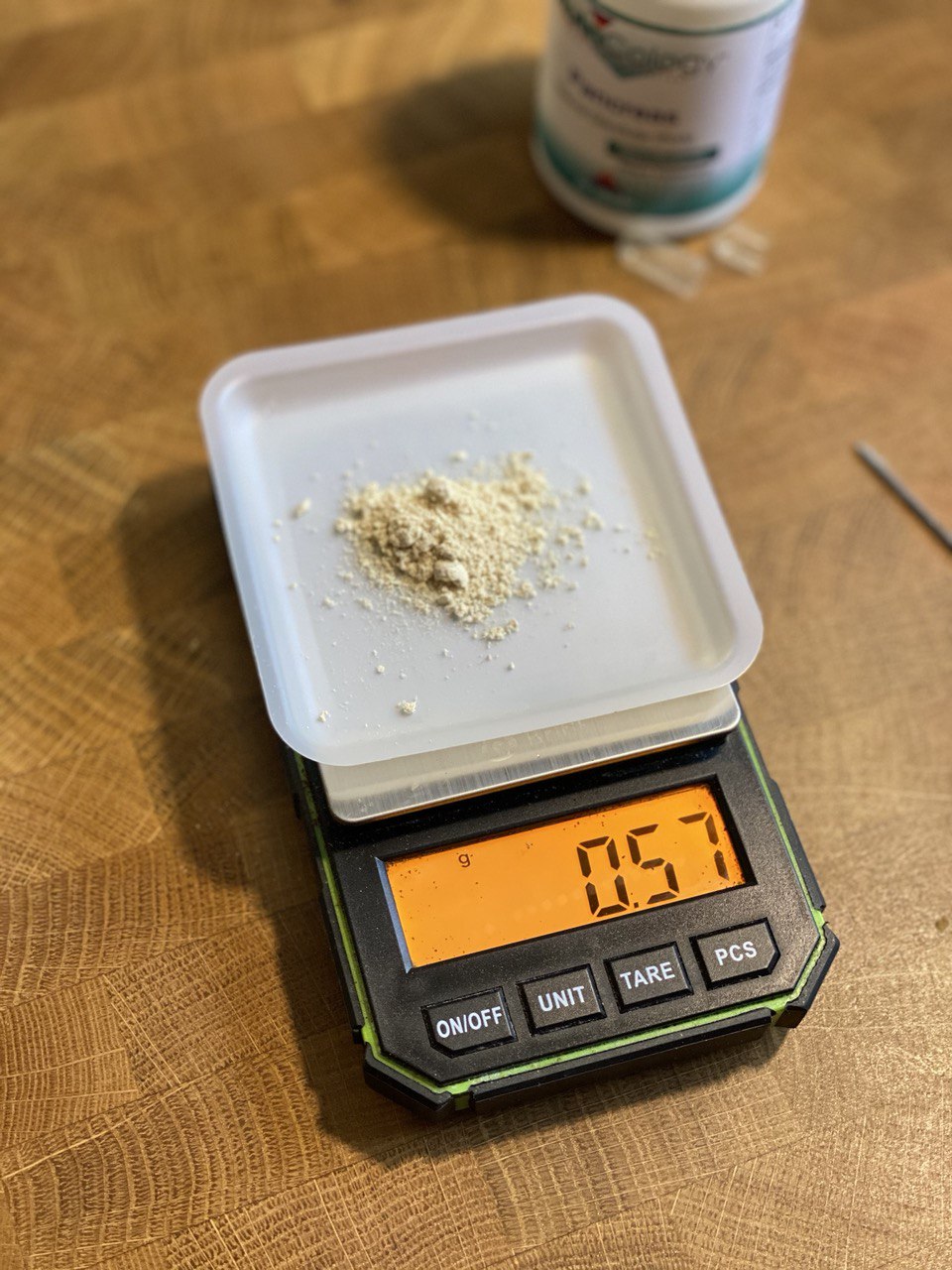
As the protein base I had bee pollen, which is very high in proteins and has beautiful flower notes.
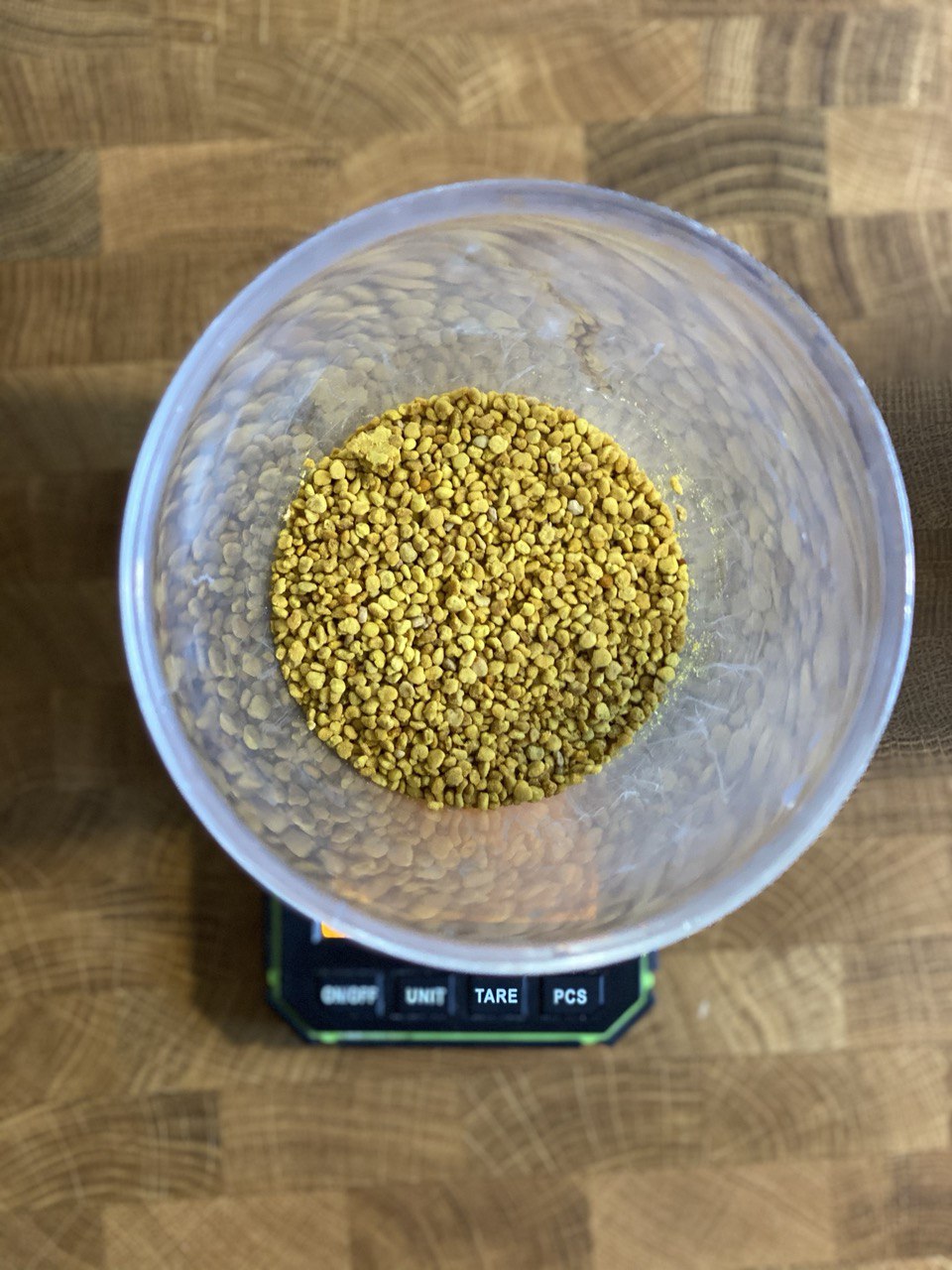
And roasted grasshoppers, which are kind of nutty in flavour.
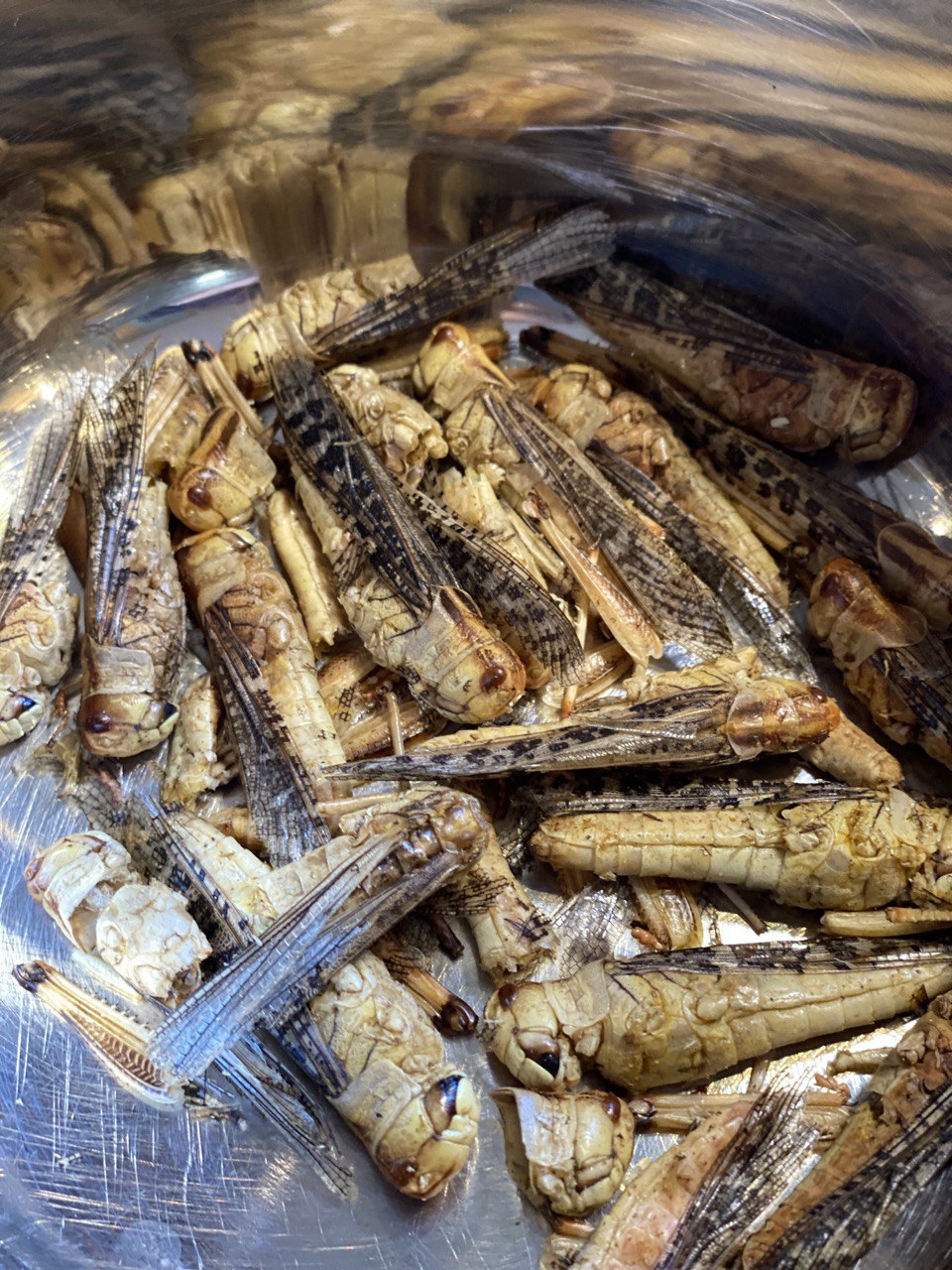
I know what you are thinking.
Hold on, Vadim, but why didn't you just use so edible flowers and hazelnuts? Glad you asked!
Flowers don't have proteins in these amounths. Hazelnuts have too much oil which destroys the enzymes.
After a few hours in sous vide, enzymes converted most of proteins and two mashes became almost transparent liquids. Strained, bottled, and mixed with a bit of salt to make it shelf-stable, each tiny bottle packs enough umami to replace litres and litres of soy sauce.
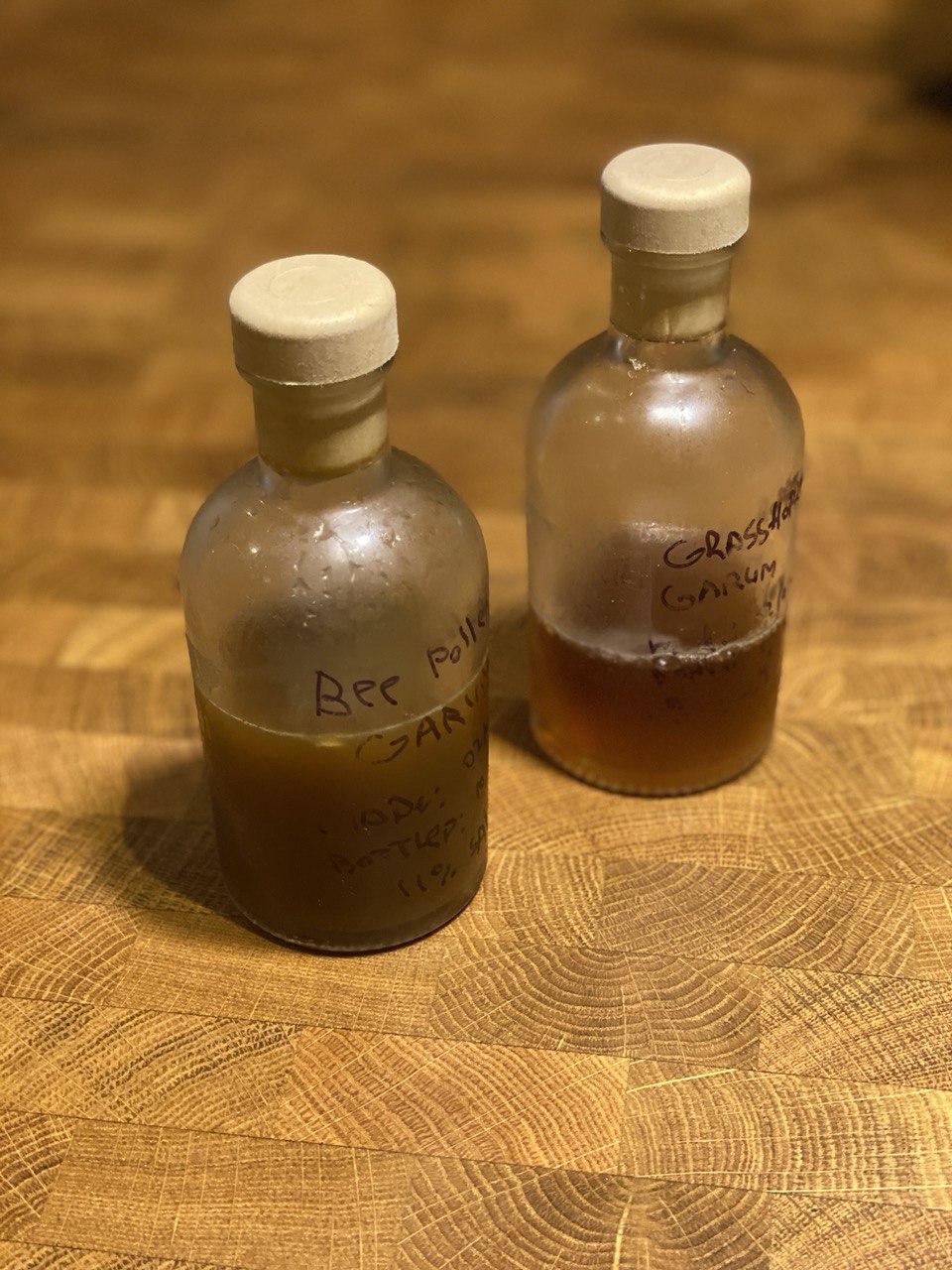
Worked great in this chicken paitan too:

Things I enjoyed reading ¶
1. Why Russians do not smile by Natalija Tancjura ¶
This is a funny coincidence: I stumbled upon the post just before engaging into an argument with a fellow Russian on grumpy faces being a very recognisable feature of any Muscovite.
In the Russian language there is a very popular saying: "Laughter without reason is the sign of foolishness." Perhaps as long as this proverb is remembered a smile will not become an indispensable part of the daily routine in Russia as it is in the Unites States.
The thing is, I do know that saying very well. This is something a teacher would tell someone in a class being too happy for no apparent reason. Or just a way to calm down a friend who is vibing better than you do.
In any case to me it always sounded as an odd mixture of annoyance and jealosy - I wonder if that's the key to the absence of smiles?
2. The great wings rush by @joshdzieza ¶
Despite the misleading title (and looking back at the previous editions, so many titles out there are misleading!), this is mostly about the rise of virtual brands.
So think of a garage with a few freezers and a stove, which bought five different virtual franchises with great photos, joined Deliveroo and Uber Eats, and now caters pretending to be five different brands at once.
“Nextbite, man, the day I opened up that brand, they put out a lot of wings,” says Brown. “I had to go shop for more wings. I had to go open up a credit account in order to just carry enough wings. I had to go buy more freezers.”
I am pretty sure this is the future of online food. Menus, ratings, reviews in the Internet matter way less than in the real world, which opens up a room for A/B testing and various experiments.
3. Somewhere Under My Left Ribs: A Nurse’s Story by @tinysunbird ¶
A really gripping story from the perspective of someone working from the operating theatre.
When an instrument is finished with, the scrub nurse turns her head and flicks her eyes to the nurse standing behind her, armed with a plastic tray, who then places that on a table behind the operating table. Nothing is removed from the room. Everything is counted, and counted again.
Gives me a mixture of House MD and Dexter feels.
4. Your browser and my browser see different colors by Matthew Szatmary ¶
While different monitors displaying different colours is a known story (and a personal trauma of anyone working as a web-designer a decade ago), browsers not being able to render the same colour on the same monitor is something very different.
And yet it is a thing.
So what did we learn? First and foremost, ALWAYS set the colorspace metadata on your videos. If you are using ffmpeg and you don't have color flags set, you are doing it wrong. Second, while ffmpeg is an amazing piece of software, its ubiquity, semi-ease of use and unfortunate defaults are problematic at best. Never assume the software is smart enough to figure it out.
Just a sidenote: this advise should apply to pretty much anything.
5. Why Did So Many Victorians Try to Speak with the Dead? by @cncep ¶
An entertaining dive into the history of people's attempts to speak with spirits (or snap with them a selfie):
If the initial Victorian wave of Spiritualism had a distinctly American character, later iterations took on global influences, as when the theosophists incorporated elements of Eastern religions, including belief in reincarnation and past lives. Immigration and translation brought sacred literatures into renewed contact with one another—the Bardo Thodol handed to readers of the Zohar, the Vedas and the Upanishads circulating alongside Julian of Norwich and Meister Eckhart.
Apparently a third of Americans these days tried the same - that's a tad unexpected.
6. If You Frame It Like That by Lincoln Perry ¶
One of the very few startups I really loved from the first sight was Instagram.
Somehow I pretty much instantly felt the power of a limitation: being able to post only squared photos felt to me like a simplest an yet the most powerful tool one could get to unlock creativity.
The frame’s orientation also influences the way we see what’s depicted within. A horizontal rectangle might suggest a landscape vista or, like a Chinese scroll, movement through time, where the past becomes occluded, the present visible, and our future viewable only through unrolling.
Taking users' choice and putting constraints became one of my weapon of choice when building things - seems like the artists of the past would agree.
7. Global Cactus Traffickers Are Cleaning Out the Deserts by Rachel Nuwer ¶
Somewhere out there a cacti mafia actually exists. They scavenge deserts and smuggle plants, so you could never know where does that huge agave on Ebay come from.
Many cactus species are highly localized, found, for example, only on certain steep limestone cliffs in Mexico, or a single sandy patch of less than one square mile on Peru’s coast. They also tend to be extremely slow-growing. Larger specimens, which are more highly sought after, can be decades or even hundreds of years old. These features make cactuses particularly sensitive to over-harvesting, but also particularly attractive to collectors interested in exclusivity.
I still wouldn't mind a huge agave plant in the garden though...
8. The Anxiety of Influencers by Barrett Swanson ¶
Despite being as far from Tik-Tok as I am from being a vegan (i.e very far), I really enjoyed that story which shows that humans could get even simpler than characters of Monty Python's episodes.
This reminds me of something that Amir told me earlier in the weekend, that the collab-house phenomenon will be the model for brands moving forward and that someday all major businesses will have their own influencer residences—the McDonald’s collab house, the Jeep Wrangler collab house, or even, god forbid, the Viagra collab house. How long before other industries will be forced to embrace this trend?
Although I must say that some quotes made me do a facepalm. I guess that's the price.
9. America Has a Drinking Problem by Kate Julian ¶
This is a slightly different perspective onto Americans settling in on the other side of the pond, but then who doesn't have a drinking problem these days?
The Mayflower landed at Plymouth Rock because, the crew feared, the Pilgrims were going through the beer too quickly. The ship had been headed for the mouth of the Hudson River, until its sailors (who, like most Europeans of that time, preferred beer to water) panicked at the possibility of running out before they got home, and threatened mutiny.
Or maybe I am just biased because at one of my previous companies the HR would always start a 1-2-1 with carefully asking if I find our company's culture mostly evolve around drinking.
I would usually sip my 11 am Bloody Mary and disagree.
10. The Leg at the Bottom of the Sea by @davidkushner ¶
I spent in the Internet more than 80% of my life, and seen people finding long lost relatives, phones dropped from airplanes, family recipes, yadda-yadda.
This story takes it to a new level: some folks found a leg under water, then they found its (ex)-owner.
A few days later, Elizabeth and Sebastian took the leg to a beach restaurant called Shunk Gulley, and other customers stared as they entered. “I’m sure they were wondering, What’s up with the kid with the leg?” Sebastian says. Hess walked in, wearing a blue Hawaiian shirt with surfers on the front. Sebastian knew it was him, and Elizabeth says she’d never seen him smile that wide before. “It was great to see how happy he was.”
At least they didn't find a skull - that would take a way darker turn.
Things I didn't know last Tuesday ¶
1. F-16 Problems ¶
As an engineer I mostly deal with people, and then occasionally with bugs. I usually avoid the former but then some bugs make me afraid of the latter too:
So when they were 'flying' the F-16 in simulation over the equator, the computer got confused and instantly flipped the plane over, killing the pilot [in simulation]. And since it can fly forever upside down, it would do so until it ran out of fuel.
Good that they had a simulator back then. Kind of makes writing tests a bit more meaningful.
2. The Veluwemeer Aqueduct ¶
So imagine there is a road and you want to make a bridge over it.
But what if the bridge is for boats, not humans?

Located over the N302 road, the aqueduct forms part of a lake of the same name. The road itself is interesting in and of itself, connecting mainland Netherlands to Flevoland — the largest artificial island in the world.
Makes lots of sense in the Netherlands.
3. End of the Plain Plane ¶
I got tipped off by Sasha about a wild history of in-flight meals in the past, and while picking up a single fact out of a century of eating in the air is hard, here is a fun trivia:
Italian designer Emilio Pucci was hired to design uniforms for the flight crew and ground crews, creating a total of six collections for Braniff between 1965 and 1974. One of his collections was an inter-changeable wardrobe which was questionably dubbed the “air strip” because it involved the flight attendants taking off parts of the uniform as the flight journey progressed.

4. The Hyphen-Song ¶
Punctuation is a powerful tool, and some people still remember that:
In the end, much to his chagrin, Curran lost this contest. No law was ever passed outlawing the hyphen, and it remains to this day, etched in stone on the building of the New-York Historical Society, a homage to the journey of the city and the hyphenated individuals who fought the good fight to keep the hyphen—and its many meanings—alive.
So back then in New York they'd fight for being able to use the hyphen in the name as it changes everything.
5. Chopsticks Etiquette ¶
I can't really use chopsticks properly and always retreat to a fork if I have the choice, but some of the rules around them are quite grim:
Do not pass food directly from your set of chopsticks to another's. Again, this is a funeral tradition that involves the bones of a cremated body.
Seems like now I will just stick to a fork for the time being.
6. Seven Wonders of the Peak ¶
There are wonderful places in England, including a "farting" cave (hence the name).
The Seven Wonders of the Peak were described in the 17th century by the philosopher Thomas Hobbes in his book De Mirabilibus Pecci: Being The Wonders of the Peak in Darby-shire, Commonly called The Devil's Arse of Peak. The wonders refer to places to visit in the Peak District of Derbyshire in England.

7. Grime-eating bacteria ¶
Some folks used to complain about immigrants taking their jobs, but now they just let bacteria do that for them.
Sprocati took her bugs elsewhere. In August, her group of biologists used bacteria isolated from a Naples industrial site to clean the wax left by centuries of votive candles from Alessandro Algardi’s baroque masterpiece, a colossal marble relief in St. Peter’s Basilica in Rome of the Meeting of Attila and Pope Leo.
This is pretty cool though: bacteria they use cleans up fragile pieces of art from dirt collected over generations.
8. Men's wedding rings ¶
I didn't know that men didn't wear wedding rings until the WWII, when it was popular among soldiers to use a ring as a reminder about family back home.
While the wearing of wedding rings by brides has been traced back to ancient Egypt, it is only in the latter part of the last century that more than a small minority of bridegrooms began doing the same.
It explains why very old men rings are less common among family artificats though.
9. Bidets were considered a form of birth control ¶
Ah, the creative class! The reason bidets never became common in the States was the lack of proper marketing and some questionable practices:
But even before the war, bidets were linked to sex and scandal. In the United States and Britain, when various forms of douching were thought of as a pregnancy preventive, bidets were considered a form of birth control. As Norman Haire, a birth-control pioneer, put it in 1936, “The presence of a bidet is regarded as almost a symbol of sin.” The present-day American sociologist Harvey Molotch agrees, concluding that the devices were tainted with France’s hedonism and sexuality. “Bidets have had such difficulty ... Even all the power of capitalism can’t break the taboo.”
10. Wikipedia is quite rich ¶
Every time I open Wikipedia, I get this huge banner asking me to donate (or they will kill a kitten). I donated a few times in the past and doubt it made a difference:
Its total funds, which have risen by about $200 million over the past five years, now stand at around $300 million.
Maybe next time I'd be better off supporting a local distillery.
Book of the week ¶
I tried to read Charles Spence's Gastrophysics in my mother tongue years back, and gave up thinking that as Spence is not originally a writer, no surprise it is so hard to process.
I came across it again but this time in English, and seems like it is the translator to blame, not the author – and I am really sorry for thinking of him rather low.
In fact the book is quite entertaining and opens up a plenty of unexpected ways to make dishes more spectacular, whether it's changing the texture of cuttlery or making the food move:
That said, note how the language of menus often tries to give the impression that there is still life in whatever is being served. There’s a great line in Steve Coogan and Rob Brydon’s TV series The Trip where, after a dish is introduced as “resting” by the waiter, Rob Brydon points out: “Rather optimistic to say they’re resting. Their days of resting have been and gone. They are dead.” True, but “dead” just feels like a word that should never appear on a menu.
Also I love all parts of The Trip and mentioned how I enjoyed re-reading Steve Coogan's autobiography recently. It's a great series, and the way they capture both British humour and love for food is hard to describe without spoilers.
Thank you and see you in a week! ¶
If you have any questions, or want to suggest a link for the next newsletter, please drop me a message on Twitter or reply to this email.
Cheers! 🍸